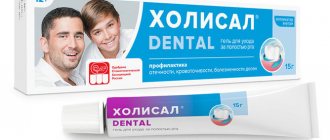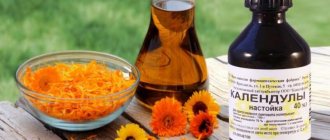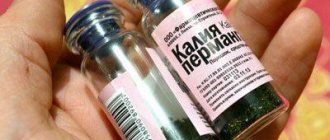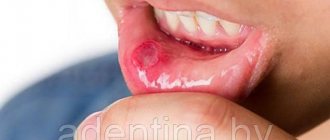Hydrogen peroxide is a substance that modern people always have at hand, because it is used in medicine and in everyday life, in clinics and at home. Recently, many useful tips have appeared on the use of this drug for rinsing the mouth for the purpose of disinfection, gum treatment and teeth whitening. But any medicine has contraindications and negative effects , so first you should figure out whether it is possible to rinse your mouth with hydrogen peroxide and how it should be diluted.
Is it possible to rinse teeth and gums with hydrogen peroxide?
You can rinse your mouth with hydrogen peroxide without harm to your teeth and body, but only with a solution with a concentration of no more than 3%. When rinsing your mouth with this liquid, several effects occur simultaneously:
Disinfection of the oral cavity.- Acceleration of healing of wounds and inflamed mucous membranes.
- Drying of the mucous membrane.
- Enamel whitening.
- Stopping minor bleeding.
- Cleansing the oral cavity from crusts, scabs, remnants of blood clots after injuries and operations.
This complex effect has led to the widespread use of this product in dentistry. Dentists prescribe peroxide rinses for the following conditions:
- Oral infections – stomatitis, candidiasis.
- Inflammatory processes - gingivitis, periodontitis, periodontal disease.
- Bleeding gums.
- Presence of dark spots on the enamel.
- The presence of bad breath is halitosis.
The product is used in the treatment of sore throat, otitis media and runny nose, as well as when lips become inflamed due to herpes. To do this, take a diluted solution, but it can only be used after consultation with the attending physician.
How to carry out the procedure?
To prepare a solution for mouth rinsing, you need to purchase a 3% solution of hydrogen peroxide and dilute it with clean, warm boiled water in the proportion of 15 drops of peroxide per 100 ml of water. If hydroperite is to be used, 1 tablet is dissolved in a glass of water.
The essence of the procedure is very simple - you need to take the solution into your mouth and rinse your mouth for a couple of minutes . The liquid is then spat out and collected again. Each time for the procedure, you should prepare a fresh portion of the solution - you cannot store the prepared solution.
As mentioned earlier, to relieve the unpleasant aftertaste, it is recommended to rinse your mouth with clean water at the end of the procedure. To consolidate the positive effect, you can rinse your mouth after peroxide with a decoction of medicinal herbs - chamomile, sage or mint.
It is recommended to rinse with peroxide several times a day . As for the course of therapy, it depends on the cause of bad breath. For example, for stomatitis or periodontitis, the course of treatment is a week.
If the cause of the unkempt odor is aphthous stomatitis, it is better not to rinse your mouth with peroxide, but to soak cotton pads in it and apply them to the affected areas for 1 minute. This procedure should also be carried out several times a day. You need to rinse your mouth more than half an hour before meals.
If, when rinsing, unpleasant sensations are observed - itching or burning, the procedure should be stopped immediately , and the oral cavity should be thoroughly rinsed with water. If peroxide has caused severe irritation of the mucous membranes, it is recommended to rinse your mouth with infusion of chamomile.
Experts advise avoiding the consumption of acidic and alkaline foods during treatment. You should also refrain from drinking alcohol and coffee - these habits negatively affect the gums and mucous membranes, and also accelerate the development of inflammatory processes in the oral cavity.
There is another way to use hydrogen peroxide - massage your gums with peroxide and soda balls. The recipe is simple :
- a teaspoon of soda is mixed with 10 drops of a 3% peroxide solution;
- the mixture rolls into a hard ball;
- the ball is applied to the gums and a 10-15 minute massage is performed;
- The therapeutic course continues until the bad breath is completely eliminated.
Important! It is not advisable to use peroxide to rinse your mouth for a long time - it may dry out the mucous membranes and damage them.
We invite you to watch an informative video about rinsing the mouth with hydrogen peroxide:
Cautions when rinsing teeth with hydrogen peroxide
To many, hydrogen peroxide seems like the most harmless antiseptic, but it has many contraindications and requires caution when used. The drug should not be used:
- For severe bleeding gums in patients with periodontitis.
- If there are a large number of fillings.
- Patients with a thin layer of enamel and caries.
- During pregnancy and lactation, due to the possible consequences of rinsing the mouth with hydrogen peroxide, not only for the mother, but also for the baby.
- For the treatment of children under 12 years of age. Children may rinse incorrectly and swallow the product. In addition, they are more sensitive to the unpleasant taste of the drug, which may cause them to vomit.
- During antibiotic treatment.
Hydrogen peroxide should not be taken orally. A solution with a concentration of more than 3% should not be used even for rinsing the mouth; it should be diluted.
Hydrogen peroxide must not only be used correctly, but also stored with precautions. A bottle of peroxide solution, perhydrol or hydroperite tablets - other pharmacological forms of this drug - should not be left in places accessible to children. Poisoning with this drug can be fatal. It is better to store the drug in a closed cabinet in a room where there is no strong increase in air temperature, otherwise it will lose its properties.
Is it possible to put hydrogen peroxide in your ears?
Drops are effective in the presence of an ear infection, as well as in cases of blockage in the ear. But if you have such problems, you should not rely on hydrogen peroxide alone, but you need to inform a specialist about this, otherwise the problem may only worsen.
Earwax is not an infection, but it can cause blockages. In this case, you can use a couple of drops of hydrogen peroxide and olive oil. Instill the resulting solution into the ears. After the procedure, you can rinse your ears a little under warm water.
Some people claim that if you drop 2-3 drops of the solution into your ears, it will help get rid of flu germs and viral diseases.
How to properly prepare the solution and rinse your mouth
Before you rinse your mouth with hydrogen peroxide, you need to dilute it. It is recommended to take a tablespoon of hydrogen peroxide per glass of water. The solution should not be hot, but not cold either. Rinsing begins only after thoroughly brushing your teeth and rinsing the mouth with clean water; such manipulations will prevent unwanted chemical reactions between the components of the drug and the toothpaste.
The peroxide solution should not be kept in the mouth for too long; it is recommended to carry out the procedure for no longer than 10 minutes. During this time, you should periodically spit out the liquid and put a fresh portion into your mouth. After the procedure is completed, the product is spat out so that it does not remain in the mouth or enter the digestive system.
If the rules of rinsing are violated, nausea and vomiting may occur; in severe cases, burns of the digestive organs may occur. If you feel a strong burning sensation during the procedure, especially if there are ulcers on the oral mucosa, you should stop rinsing and rinse your mouth with clean water.
ATTENTION!!!
— When working with perhydrol, you must wear rubber protective gloves and safety glasses. - Not to drink! - Hide from the sun! — Keep away from children and pets! — Try not to get the substance into your eyes or skin. - You cannot pour it into another container. — Store vertically and in a dark place! — Do not mix with other cleaning and disinfecting substances.
Hydrogen peroxide at a concentration of 37% or 60% decomposes in an aqueous environment into active oxygen and water, thereby oxidizing all organic compounds, metals and non-metals. With constant use of the pool, even by one person, it cannot be avoided from becoming dirty.
Hydrogen peroxide reacts with all substances to form precipitates that are easily filtered. This substance also disinfects water from fungi, protozoan microorganisms and viruses.
Can peroxide be used to whiten teeth?
Hydrogen peroxide can be used to whiten tooth enamel only if there are no contraindications. To make sure that the enamel layer is strong enough and not too thin, it is better to visit a dentist and consult with him about the possibility of using this product.
The following whitening methods are known:
- They take a mixture of hydrogen peroxide and soda, sometimes diluted with eucalyptus oil. The paste is applied to a toothbrush. After brushing your teeth, you need to rinse your mouth. Food can be taken no earlier than 20 minutes after the procedure.
- Three drops of the product are placed on toothpaste; it is recommended to use toothpaste for the treatment of periodontal disease.
- If there is a limited stain on the enamel, you can clean it with a cotton swab dipped in hydrogen peroxide. But first you need to undergo an examination by a dentist so as not to provoke the destruction of the enamel.
- Instead of a pharmaceutical 3% solution, sometimes they take hydroperite tablets and dissolve them in clean water: 2 tablets per 100 ml.
Teeth before and after whitening with hydrogen peroxide
Disinfection with hydrogen peroxide
Hydrogen peroxide is a universal household disinfectant. They can be processed:
- clothes;
- underwear;
- Kids toys;
- plumbing;
- furniture;
- premises;
- devices and care items.
Disinfection can be carried out by soaking objects/things, irrigation or wiping. The exposure time and concentration of the active substance will depend on the type of pathogen that needs to be neutralized.
To sterilize instruments in medical institutions, 6% hydrogen peroxide is used. The product is packaged in special containers and sent directly to medical institutions. In this case, special equipment is used, since disinfection occurs with peroxide vapor. This composition is not used for household or medical purposes.
To view lifehacks with the drug:
Purification and disinfection of pool water with hydrogen peroxide is carried out as follows:
- the water is drained;
- the sides and bottom are thoroughly washed with brushes;
- surfaces are wiped with a 6% solution;
- leave for an hour;
- wash off 3-4 times.
You can add hydrogen peroxide directly to water. Proportions for 30% perhydrol are from 500 to 1400 g per 1 ton of water, depending on the severity of pollution. The exposure time is 1–2 days. After this, the contents are drained and the pool is washed off. You can collect water for bathing after a day.
In order to disinfect the well and well, 1 liter of 37% peroxide is added to each cubic meter and left for a day. Everyone downloads it - you can’t use this kind of water.
Disinfection of an aquarium with hydrogen peroxide is carried out as follows: all inhabitants are placed in other containers. Add 100 ml of a 6% solution to 10 liters of water, keep for 6 to 24 hours, then pour out. Wash all surfaces.
In brewing, a 6% solution is used to disinfect surfaces. If there is 37% perhydrol, then it is pre-diluted 1 to 6.
Watch the video on the topic:
Indoor floors and surfaces
To disinfect door handles, a napkin or rag is moistened with 3% hydrogen peroxide and wiped thoroughly without rinsing with water.
The floor, walls, furniture are treated with 3% peroxide, spraying them with a spray bottle and wiping with a clean cloth. Avoid contact of the solution with varnished surfaces and metal objects. To disinfect the premises, it is enough to carry out such treatment once a month.
If 37% peroxide is used to disinfect premises, it must be diluted 12 times with water to obtain a working 3% solution.
Disinfectant soak
If necessary, disinfection and antiseptic treatment of shoes/clothing/linen, dishes, small items should be soaked in a 4% solution of hydrogen peroxide. For a kilogram of dry laundry you will need 4 liters of product.
After soaking in the solution, things or objects are washed and then rinsed in clean water.
For kitchen
A good cleaning effect is achieved by using 4% hydrogen peroxide in the kitchen to treat and disinfect enamel dishes, cutting boards, cabinets, countertops, and non-metallic objects.
- Small objects are immersed in the solution, and large ones are sprayed with a disinfectant. After 30 minutes, wipe with a damp cloth.
- Dish sponges, towels, rags are placed in a plastic basin or bucket, filled with a 5% solution for 30 minutes, and then rinsed in running water.
- To treat and disinfect garbage cans, 6% peroxide is sprayed on their internal and external surfaces using a spray bottle and left for an hour. Then wipe with a damp cloth without rinsing off the solution.
Mirror and glass
A 3% solution, which is sprayed and left for 15 minutes, will help to disinfect glass, mirrors, and also clean them of dust. After this, wipe with a soft dry cloth until shiny.
For cleaning the bathroom
To disinfect bathtubs, sinks, tiles, and enamel surfaces, irrigate them generously with a 4% solution. After 30 minutes, wipe with a damp cloth.
The walls of the shower stall are moistened with a 5% solution and left for half an hour. After this, wash off with water. 6% peroxide is poured into the drain holes and left for 1–2 hours.
Such treatment should be carried out once every 3 months.
Watch the video:
Toilet
To disinfect the toilet bowl and brush, use a 6% peroxide solution. The plumbing fixtures are generously moistened with it, and the brush is placed in a container with the solution.
Rinsing your mouth with hydrogen peroxide to remove odor
Halitosis can be caused by many dental and internal diseases. Hydrogen peroxide helps get rid of unpleasant odor if the cause of its occurrence is related to the condition of the oral cavity. Rinsing the mouth with this product for gumboils, periodontal disease, stomatitis, and gingivitis helps eliminate pathogenic microflora from the surface of the oral mucosa. And along with it, the smell, which is a consequence of the vital activity of microbes, disappears.
If the cause of halitosis is diseases of the internal organs, hydrogen peroxide will not be able to effectively combat oral odor. Disturbances in the functioning of the kidneys and liver, diabetes mellitus provoke the appearance of various foreign odors from the mouth, even with an admixture of chemicals: acetone, ammonia. They also cannot be eliminated by rinsing; targeted complex treatment is necessary.
In case of dysbacteriosis or infectious inflammation of the ENT organs, which also cause a putrid odor in the mouth, peroxide, when used correctly, can reduce the intensity of the amber.
To rinse your mouth, hydrogen peroxide must be diluted with water (pre-boiled). You need to rinse your teeth and gums for a minute 1-3 times in a row, after which the mouth is rinsed with clean water. The procedures are done three times a day for 3–5 days.
Pros and cons of using hydrogen peroxide to treat teeth and gums
Based on the available reviews and opinions of people who have used hydrogen peroxide solution for mouth rinsing, this product has the following advantages and disadvantages:
| Advantages | Flaws |
| Complex therapeutic effect, noticeable improvement in oral health. | Possible consequences if used incorrectly. |
| The safety of rinsing gums with hydrogen peroxide if the proportions are observed. | Unpleasant taste in the mouth during and after the procedure. |
| Availability in all pharmacies and low price. | Burning in the mouth when rinsing, especially in the presence of wounds. |
People who often rinse their teeth with this product recommend rinsing their mouth with an infusion of herbs with a pleasant smell after the procedure. This helps reduce the feeling of unpleasant taste and prevent the gag reflex. If you feel a burning sensation, you can dilute the solution to a lower concentration.
Hydrogen peroxide is a useful, widely available remedy that helps fight the symptoms of various dental inflammations. Therefore, it is often prescribed in dentistry and otolaryngology.
To dilute peroxide in the correct proportions in each specific case, an individual consultation with a clinic physician or dentist is advisable. After using the product for any purpose, rinse your mouth thoroughly with boiled water.











